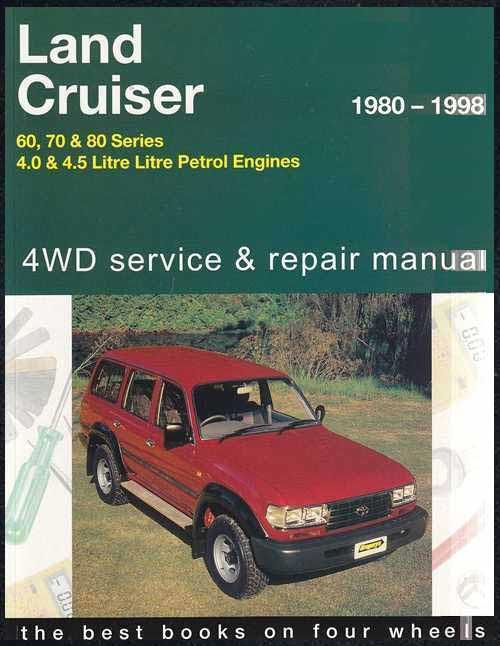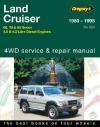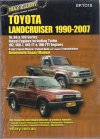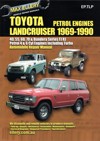Toyota Landcruiser 60 70 and 80 series 1980-1998 Petrol Gregorys Repair Manual - NEW
Toyota Landcruiser Petrol 60 70 and 80 series 1980 - 1998 Gregory Repair Manual NEWNEW paperback Toyota Land Cruiser 60 70 and 80 Series (Petrol) 1980 - 1998 Gregorys Owners Service & Repair Manual covers Toyota Landcruiser Petrol 1980 August to 1998 covers FJ60,FJ62,FJ70,FJ73,FJ75,FJ80, FZJ80 series Hardtop, wagon,Utility, Ute,cab,chassis,troop carrier. 4.0 litre (3F) engines, 4.5 litre (1FZ-FE) 6 cylinder petrol engines
|
The Toyota Land Cruiser is a series of four-wheel drive vehicles produced by the Japanese car manufacturer Toyota. The Land Cruiser series is the longest running series in Toyota history.
Production of the first generation Land Cruiser began in 1951 (90 products) as Toyota's variation of a Jeep-like vehicle. The Land Cruiser features been produced in convertible, hardtop, section wagon, and utility truck variations. The Land Cruiser's longevity and reliability has led to big popularity, especially in South Sudan and Australia where it may be the best-selling body-on-frame, four-wheel drive vehicle. Toyota additionally extensively tests the Land Cruiser in the Australian outback thought about to be among the toughest operating environments both in temperature and terrain. Main rivals include the number Rover, Land Rover Discovery, Jeep Wrangler, Mitsubishi Pajero and Nissan Patrol. In Japan, the Land Cruiser is exclusive to Toyota Japanese dealerships called Toyota shop.
When powering two tires simultaneously the tires has to be allowed to rotate at various speeds as the automobile goes around figure. This is accomplished with a differential. A differential allows one feedback shaft (e.g., the driveshaft of a car or truck) to drive two output shafts (e.g. - shaft shafts that go out of the differential to the wheel) independently with various speeds. The differential distributes torque (angular force) evenly, while distributing angular velocity (turning speed) in a way that the average for the 2 output shafts is equivalent to compared to the differential ring gear. Each powered axle requires a differential to disperse power between the left and right sides. When all four wheels are driven, 'center or third' differential can be used to distribute power between the front and back axles.
The described system handles extremely well, as it is able to support various causes of movement and disperse power equally and efficiently, generating slippage unlikely. Once it does slide, however, recovery is difficult. If the remaining front wheel of a 4WD vehicle slides on an icy area of road, for instance, the slipping wheel will spin faster than the other wheels because of to the reduced traction at that wheel. Since a differential applies equivalent torque to each power, half-shaft is reduced at the other wheels, even whether they have great traction. This problem could happen in both 2WD and 4WD vehicles, whenever a driven wheel is placed on a surface with little traction or raised from the ground. The simplistic design works acceptably really for 2WD vehicles. Information technology is much less acceptable for 4WD vehicles, because 4WD automobiles have twice as many wheels with which to lose traction, increasing the likelihood that it may happen. 4WD vehicles can also be much more likely to generate on surfaces with reduced traction. However, since torque is divided amongst four wheels somewhat than two, each wheel receives approximately half the torque of a 2WD vehicle, reducing the chance of wheel slip.
In 1941 the Imperial Japanese Army occupied the Philippines, in which they discovered an old Bantam Mk II jeep, and promptly brought it to Japan. The Japanese military authorities commanded Toyota to create a similar vehicle but to not model the appearance on the American Jeep. The prototype was known as the Model AK and was formally adopted through the Japanese Imperial Army since the Yon-Shiki Kogata Kamotsu-Shatype 4 compact cargo-truck).
Later in 1941 the Japanese federal government questioned Toyota to create a light truck for the Japan military campaign. Toyota developed a-ton prototype called the AK10 in 1942. The AK10 was constructed using reverse-engineering from the Bantam GP. The truck featured an upright front grille, flat front wheel arches that angled down and back like the headlights, FJ40 mounted above the wheel arches on either side of the radiator, and a folding windshield.
The AK10 used the 2259 cc, 4-cylinder Type C engine from the Toyota Model AE sedan with a three-speed manual transmission and two-speed transfer gearbox hooked up to it. There is no mechanical relationship between the AK10 and the postwar Toyota "Jeep" BJ. Many of the AK10's were maybe not actively used (unlike the U.S. Jeep) and there are almost no photographs from it in the battlefield.
The Toyota J40 is the model designation for a Toyota Land Cruiser 40 series made from 1960 until 1984 (in Brazil, where it was referred to as Toyota Bandeirante, it was made from 1958 until 2001). Most 40 series Land Cruisers were built as two-door vehicles with slightly larger dimensions than a Jeep CJ.
The design ended up being available as the FJ40 series (with F engines) and also BJ40/41/42 (short wheelbase), BJ43/44/46 (heart wheelbase) or HJ45/47 (long wheelbase) designation where it had a Diesel motor. The Land Cruisers constructed in Brazil from 1958 to 1962 received the series signal FJ25 (topless) and FJ25L (soft leading) but they are often referred to as FJ-251, and in 1961 thanks to a new motor called 2F - not to be confounded with the subsequent 2F engine from 1975 - there still came out some few units with the series code FJ-151L (soft top). With the model name changed to Bandeirante after 1961, those built from 1962 to 1993 - with Mercedes-Benz motors - obtained OJ50/55 series and those developed from 1994 to 2001 - with Toyota engines - BJ50/55 series model codes.
References to the series in this short article will be to the J40 series unless referring to one of the petrol (FJ40/42 2WD) or diesel (BJ4#/HJ4#) models specifically.
For any history of the J series from the original 1951 Toyota Jeep BJ through the J20 show see Land Cruiser History from 1950 to 1955.
1960: J40 series launched (wheelbase 2,285 mm (90 in)/2,430 mm (96 in)/2,650 mm (104 in)).
1963: more time wheelbase (2,950 mm (116 in)), FJ45-B, cab-chassis and pickup were extra).
1967: End of four-door FJ45V (we) (w/b 2,650 mm (104 in)) production, changed by FJ55 Station wagon).
2-door FJ45-B renamed FJ45 (II) (w/b 2,950 mm (116 in)).
1973?: HJ45 launched with the 3.6-litre, H inline 6-cylinder diesel engine.
1974: BJ40/43 launched with the 3.0-litre, B inline 4-cylinder diesel engine. A factory-fitted roll bar becomes standard in the United States.
1975: Rear ambulance doors tend to be added to US model FJ40s. The lift gate remains available as an option in other countries.
1976: Disc brakes on the front axle.
1977: forward home vent windows, vent, removed windows on the hard top into the United States
1979: Power steering (just F models) and air training included with the gear, possibilities percentages modified from 4:10 to 3:70 in the United States to be more freeway friendly
1980: HJ47 established with a 4.0-liter six-cylinder diesel engine. End of HJ45 production.
BJ42/46 and BJ45 launched with a 3.4-liter four-cylinder diesel engine.
1981: Power direction added on the BJ types to the choices, disk brakes added in Australia.
1984: End of J40 series production (changed by J70 series).
1993: Five-speed transmission becomes readily available for the Toyota Bandeirante.
1994: In Brazil, the Mercedes-Benz OM-364 motor is replaced by the Toyota 14B unit.
2001: End of Bandeirante production.
The J40/41/42 had been a two-door brief wheelbase four-wheel-drive automobile, with either a gentle or a hardtop (V). It was available with various gas or diesel (from 1974) engines over its life time. It was replaced of all areas from 1984 by the J70 series (70/71).
The FJ42 is 4X2 product, for only The Middle East.
The J43/J44/46 was an extremely uncommon two-door medium wheelbase four-wheel-drive vehicle, with either hard-top or soft (V). It was replaced on most areas from 1984 through the J70 line (73/74).
The J45/47 was a long-wheelbase four-wheel-drive vehicle, available in two-door hardtop, three-door hardtop, four-door station wagon and two-door pickup models. The four-door station wagon model (FJ45V-I) was the shortest-lived of the J40 series, mainly because it was changed by the FJ55G/V in 1967.
The Bandeirante TB25/TB41/TB51 Series are J2 series built in Brazil by Toyota do Brasil Ltda from 1962 to 1966/68. In 1966 they were replaced because of the OJ32 (soft top) and OJ31 (hard top) for any TB25, and the TB81 for the TB51; for an unknown reason the TB41 would keep its J2 code until 1968 when Toyota do Brasil switched out of the J2 to the J3 series in 1966.
The Bandeirante OJ40/OJ45 Series (1968 to 1973), OJ50/OJ55 Series (1973 to 1994) and BJ50/BJ55 Series (1994 to 2001) are J4 series built in Brazil by Toyota do Brasil Ltda from 1968 to 2001. Identical to the BJ40 in almost every respect, it had several stylistic modifications to the grille (designs created from 1989 on featured square headlights, instead of the round ones used before) and used Mercedes-Benz OM-314/OM-324/OM-364 diesel engines (replaced by Toyota 14B inline 4 direct injection Diesel engine in 1994) for much of its production life; another visible mayor characteristic are the entire hind doors (like at Land Rover) rather than the traditional Toyota two-wing hind doors during the Bandeirante's hard top models.
1959:
FJ25 - Short open (topless) bushdrive car - engine Toyota F (May 1959 to 1960/61) - new in 1959 (also described as FJ251)
1960/1961:
FJ25L - Short soft top bushdrive car - motor Toyota F (1960/1961 to 1960/1961) - new in 1960/1961 (in addition referred to as FJ251L)
FJ151L - Short soft top bushdrive car - motor Toyota 2F (1960/1961 to December 1961) - replaces the the FJ25L/FJ251L and FJ25/FJ251 (there are few mentions in literature and no preserved unit known; it could be even doubted if it's ever already been actually built.
1962:
TB25L - Short smooth top bushdrive car - motor Mercedes-Benz OM-324 (January 1962 to - 1966? - before August 1968) - replaces the FJ151L (or FJ25L/FJ251L?)
TB25L - Quick hard top bushdrive car - engine Mercedes-Benz OM-324 (January 1962 to - 1966? - before August 1968) - new in 1962
TB41L - Long hard leading bushdrive car - motor Mercedes-Benz OM-324 (September 1962 to July 1968) - new in 1962
TB51L - Short collection with native sleep - motor Mercedes-Benz OM-324 (September 1962 to January 1966)
1965:
TB51L3 - Short 3-door double cabin pickup with native steel and bed bed cover - motor Mercedes-Benz OM-324 (? < 1965 < ?) - brand-new in 1965; possibly there could have been built one device only
1966? (between 1962 and 1968):
OJ32L - Short soft top bushdrive car - motor Mercedes-Benz OM-324 (before August 1968 - 1966? - to August 1968) - replaces the soft top TB25L
OJ31L - brief tough top bushdrive car - motor Mercedes-Benz OM-324 (before August 1968 - 1966? - to August 1968) - replaces the hard very top TB25L
TB81L - Short pickup with native bed - motor Mercedes-Benz OM-324 (February 1966 to August 1968) - replaces the TB51L
1968:
OJ40L - Short soft top bushdrive car - engine Mercedes-Benz OM-324 (September 1968 to January/February 1973) - replaces the OJ32L
OJ40LV - Short hard top bushdrive car - motor Mercedes-Benz OM-324 (October 1968 to January/February 1973) - replaces the OJ31L
OJ40LV-B - Long hard top bushdrive auto - motor Mercedes-Benz OM-324 (October 1968 to January/February 1973) - replaces the TB41L
OJ45LP-B - Short collection with native bed - motor Mercedes-Benz OM-324 (September 1968 to January/February 1973) - replaces the TB81L
1973:
OJ50L - Short soft top bushdrive car - motor Mercedes-Benz OM-314 (February 1973 to November 1989) - replaces the OJ40L
OJ50LV - Short hard top bushdrive car - motor Mercedes-Benz OM-314 (February 1973 to November 1989) - replaces the OJ40LV
OJ50LV-B - Long hard top bushdrive auto - motor Mercedes-Benz OM-314 (February 1973 to November 1989) - changes the OJ40LV-B
OJ55LP-B - Short pickup with native bed - motor Mercedes-Benz OM-314 (February 1973 to November 1989) - replaces the OJ45LP-B
between 1973 and 1989:
OJ55LP-B3 - Short chassis-cab collection - motor Mercedes-Benz OM-314 (19?? to November 1989) - new in 19??
OJ55LP-BL - lengthy pickup with native sleep - motor Mercedes-Benz OM-314 (19?? to November 1989) - new in 19??
OJ55LP-BL3 - Short chassis-cab pickup - motor Mercedes-Benz OM-314 (19?? to November 1989) - new in 19??
OJ55LP-2BL - Long 2-door double cabin pickup with native bed - motor Mercedes-Benz OM-314 (19?? to November 1989) - new in 19??
1989:
OJ50L - Short soft top bushdrive car - motor Mercedes-Benz OM-364 (November 1989 to April 1994) - changes the OJ50L with Mercedes-Benz OM-314 engine
OJ50LV - Short hard top bushdrive car - motor Mercedes-Benz OM-364 (November 1989 to Abril 1994) - replaces the OJ50LV with Mercedes-Benz OM-314 motor
OJ50LV-B - Long difficult top bushdrive car - motor Mercedes-Benz OM-364 (November 1989 to Abril 1994) - replaces the OJ50LV-B with Mercedes-Benz OM-314 motor
OJ55LP-B - Short pickup with native bed - motor Mercedes-Benz OM-364 (November 1989 to Abril 1994) - replaces the OJ55LP-B with Mercedes-Benz OM-314 motor
OJ55LP-B3 - Short chassis-cab pickup - motor Mercedes-Benz OM-364 (November 1989 to Abril 1994) - changes the OJ55LP-B3 with Mercedes-Benz OM-314 motor
OJ55LP-BL - lengthy pickup with native bed - motor Mercedes-Benz OM-364 (November 1989 to Abril 1994) - changes the OJ55LP-BL with Mercedes-Benz OM-314 motor
OJ55LP-BL3 - Long chassis-cab pickup - motor Mercedes-Benz OM-364 (November 1989 to Abril 1994) - replaces the OJ55LP-BL3 with Mercedes-Benz OM-314 motor
OJ55LP-2BL - Long 2-door double cabin pickup with native bed - motor Mercedes-Benz OM-364 (November 1989 to Abril 1994) - replaces the OJ55LP-2BL with Mercedes-Benz OM-314 motor
1994:
BJ50L - Short soft very top bushdrive vehicle - motor Toyota 14B - April 1994 to November 2001 - replaces the OJ50L
BJ50LV - Short hard top bushdrive car - motor Toyota 14B - April 1994 to November 2001 - replaces the OJ50LV
BJ50LV-B - Long hard top bushdrive vehicle - engine Toyota 14B - April 1994 to November 2001 - replaces the OJ50LV-B
BJ55LP-B - Short pickup with native bed - motor Toyota 14B - April 1994 to November 2001 - replaces the OJ55LP-B
BJ55LP-B3 - Quick chassis-cab pickup - motor Toyota 14B - April 1994 to November 2001 - replaces the OJ55LP-B3
BJ55LP-BL - Long pickup with native bed - motor Toyota 14B - April 1994 to November 2001 - replaces the OJ55LP-BL
BJ55LP-BL3 - lengthy chassis-cab pickup - engine Toyota 14B - April 1994 to November 2001 - changes the OJ55LP-BL3
BJ55LP-2BL - Long 2-door double cabin pickup with native bed - motor Toyota 14B - April 1994 to November 2001 - replaces the OJ55LP-2BL
1999:
BJ55LP-2BL4 - Long 2-door double cabin collection with native sleep - motor Toyota 14B - 1999 to November 2001 - new in 1999
On the years Toyota has changed the engines used in the J40 series. The B series motor is actually a 4-cylinder diesel, plus the H series a 6-cylinder diesel. The diesel-engined trucks were never sold to the general public in the United States Of America, though some found their way in as mine trucks. The engines are comparable, inside the series. For example, the F and 2F engines share many of the same components. However the H and 2H engines have actually almost nothing in common. You will find individual models within the engine line, for example, there is actually an F125 engine, and an F155 engine, all in the F show with different power ratings.
While maybe not appropriate in certain countries, a lot of J40 series vehicles could have their roof and doorways removed. With a folding windshield this allowed for complete open-air experience.
The J40 Series also featured folding jump seats behind the passenger and drivers seats. These folding seats not just made carrying another 2 individuals possible, but additionally allowed for optimum cargo space, as opposed to the folding rear seat in the Jeep CJ series.
Original factory winches were driven right from the transfer case (called P.T.O. or power take off) powered by the engine. Afterwards models had an optional electric winch.
There is a beneficial sized following of individuals that collect, maintain, and get their unique J-series vehicle off highway. Toyota still offers many replacement parts, available through Toyota parts departments worldwide. Many of these trucks find their home in places with severe highway conditions as work trucks, where they are used daily by their owners. Its essence lives on in the J70 series, which is actually a J40 with an updated front half and slightly different motor offerings, such as a turbo charged diesel. It offers in many countries, but was never for purchase in the USA.
For 2006, Toyota introduced the FJ Cruiser, a modern SUV styled after the initial FJ40. The FJ Cruiser (FJC) moved available for sale in the springtime of 2006.
Diesel Toys have a preferred conversion on the Toyota FJ using the Diesel motor out of the Toyota Fortuner 4WD, the Toyota 1KD-FTV D4D Diesel Engine it's recently been a popular conversion for those who want the low torque grunt and great fuel economy of a diesel.
Even though its creation ended in Brazil many years back, the Toyota Bandeirante is nevertheless very tried after, due to its good off-road performance. Thus Bandeirantes reach high prices in the Brazilian used car market, especially the rare 1993 models which were the only ones fitted with a Mercedes-Benz engine married to a five-speed sign.

 0 Items (Empty)
0 Items (Empty)



